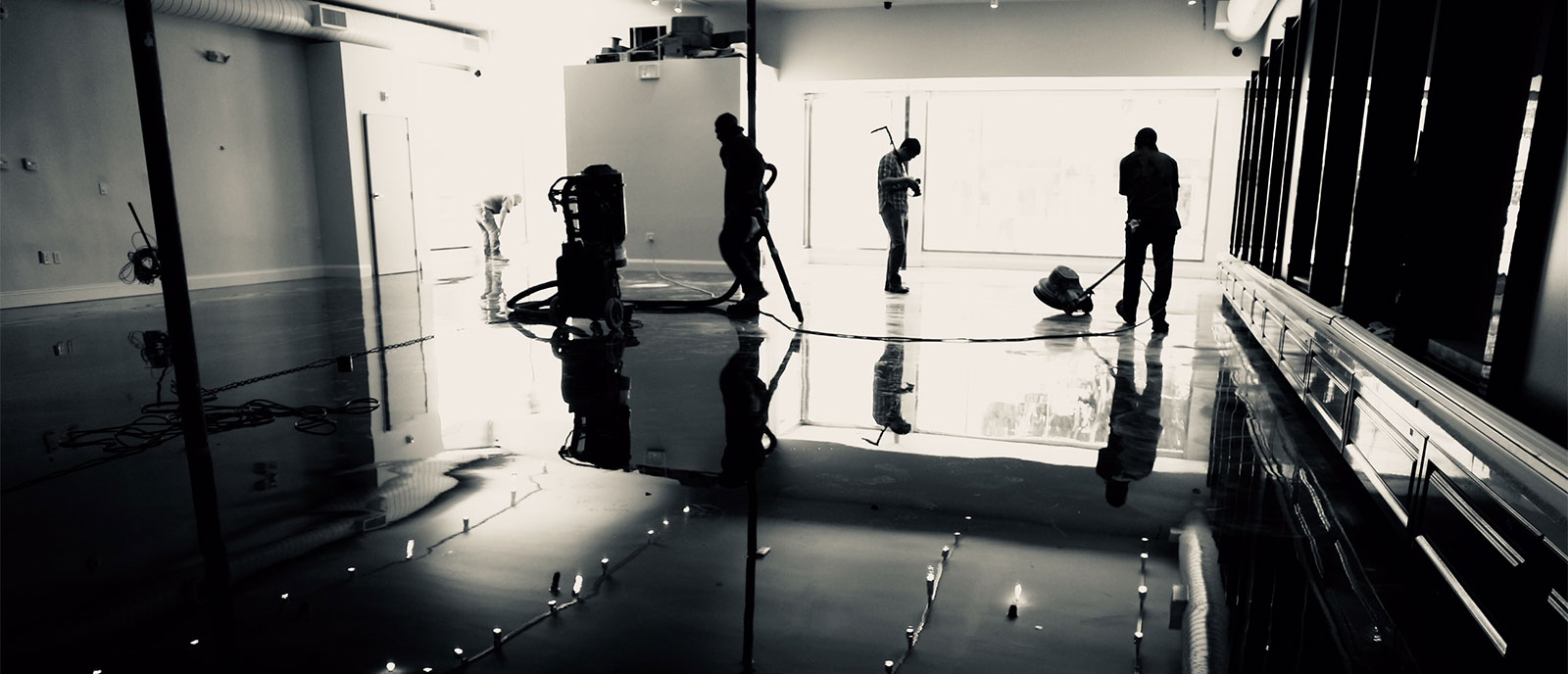How to take care of your epoxy floors
Seamless flooring systems are nonporous, making them easier to clean than any other flooring solution. These properties are what make seamless epoxy floors the easiest to maintain out of all alternatives. There is no stripping or waxing required. Just regular inspections and general upkeep and cleanliness practices.
Maintenance of Blackrock Industrial’s epoxy flooring systems must be completed at regular intervals to ensure that it will continue to provide the service for which it was intended. It is important to note the following when cleaning a Blackrock Industrial seamless flooring application:
Maintenance:
- Dirt and Grime
- Cleaning Agents
- Cleaning Procedures
- Periodic Physical Inspection
- Repairs to high torque areas and other pinch-points
Dirt and Grime
Given that debris remains on the surface, they tend to act as abrasives and will eventually mar and abrade the finished product if exposed to constant and heavy traffic. It is important that Blackrock Industrial seamless flooring systems be properly maintained on a regular basis and are kept free and clear of long term dirt and grime contamination.
Cleaning Agents
Do not use actual soap on your epoxy floors because it will create a film that is difficult to remove by rinsing. A film left behind after cleaning causes two issues: The film becomes slippery when wet and attracts and holds dirt and debris.
Floor stripping agents, citrus-based cleaners and corrosive chemical degreasers are also not recommended as they can damage your epoxy coating if they are applied too aggressively. A simple mixture of a neutral-based cleaning agent such as Simple Green, diluted with some water, is what we recommend for regularly scheduled maintenance.
Cleaning Procedures:
- Sweep the entire floor to remove any loose debris and dirt with a dry mop and/or soft bristled broom. Although Blackrock Industrial epoxy floors are impermeable, these substances will act as abrasives and contribute to potential degradation of your flooring system. If they are not regularly removed, then they will wear the floor over time.
- When using a commercial floor scrubber, a blue scrubbing pad should be used. You should not use cleaning pads that are more aggressive. Dilute the cleaning product according to manufacturer’s recommendations.
- For heavily soiled areas, a double-pass process may be used. In this process, the diluted mixture is laid down at a consistent rate with the pads spinning. The vacuum / squeegee should remain removed from the scrubber during your first pass.
- Rinse floor with clean water and use wet vacuum or squeegee to remove. A second rinsing is also suggested in some cases to ensure that no residue is left behind. Proper attention must be paid to removing the resultant emulsion of the cleaning solution and soil.
- Once dirty water has been removed, the floor must dry prior to returning to service.
- Dispose of contaminated water while paying special attention to by-law regulations prohibiting the introduction of certain chemicals into surface water drains and sewer systems.
- Avoid the use of strong solvents, especially hydro-carbon based solvents.
- If using high pressure water blast, pressure must not exceed 800 PSI at the nozzle, and temperature should not exceed 120 degrees Fahrenheit.
Waxing Procedures
Waxing a seamless epoxy floor is not necessary. However, in order to maintain an artificial shine, waxes that are specifically designed for polymer flooring systems may be used.
For high traffic interior systems with a high gloss finish, owners may select to incorporate a sacrificial wax into ongoing maintenance procedures in order to maintain the original shine of the flooring system. Follow all manufacturer’s recommendations in the application of these products.
Inspections
The coating system is subject to extreme abrasive conditions as well as to physical damage in general. Periodic inspections will provide a basis for the proper maintenance work and ensure a long-life expectancy of the flooring system.
- Monthly – Make physical inspections to determine if there are any areas with excessive wear or physical damage.
- Semi-Annually – Make a thorough physical inspection. Such inspections should include:
- Inspect the sealant in joints for proper adhesion. Also determine if there is any cohesive failure or physical damage to the sealant from traffic.
- Inspect the underside of the joints for evidence of leaks where possible.
- Inspect the areas where beams are resting on columns for evidence of stress cracking or excessive movement.
- Inspect the entire structure from the underside for cracks which show evidence of a difference in the plane of the materials on each side of the crack.
- Inspect drains or scuppers to assure there is nothing clogging or blocking them. Avoid poinding water on the surface.
- Inspect coating surfaces to determine if there are any substantial structural cracks in the substrates which have caused the coating to crack.
Coating Repair
- Minor repairs may be made by the owner’s maintenance team; however, it is suggested that major repairs be completed by Blackrock Industrial.
- For physical damage to the coating system:
- Remove loose and damaged coating materials to expose a sound substrate.
- Thoroughly sand / grind the substrate and existing coating.
- Perform a thorough solvent wipe.
- Allow solvent to evaporate (at least 1 hour).
- Apply coating system to original specifications.
- Install the coating system to the original film thickness, extending each coat onto the existing coating.
- Allow the repaired area to cure for 24 hours minimum before opening area to traffic.
In addition to these general maintenance and cleaning procedures, it should be noted that spills of petroleum distillates, hydrocarbon based solvents, lighter fluid, oil, gas, alcohols and battery acids should be cleaned up and removed from the epoxy flooring system as soon as possible. Hot oils, hot coals, charcoals and alkalis must not be allowed to drop on the deck coating in order to prevent the possibility of punctures.



